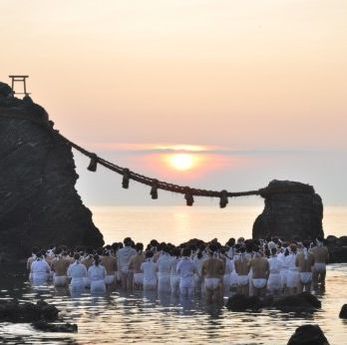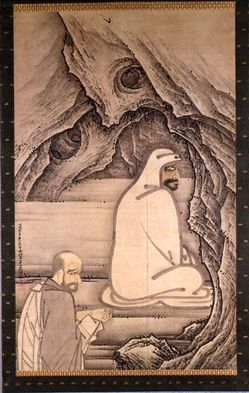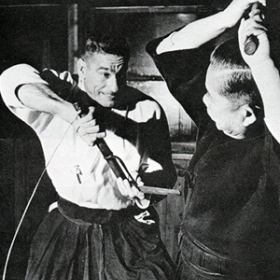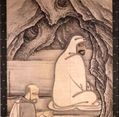Buddhist Concepts for Budo Training -part 2 - Would You Cut Off Your Arm To Study With Your Teacher?8/1/2010
 Ise Shrine - Shyugyo Ise Shrine - Shyugyo This dramatic picture shows Daruma performing Shugyo (austere training rights) in a cave. Daruma is credited with introducing Zen (Chinese Chen Style) to Japan, although this is a controversial subject open to greater academic research. Although it is said that he sat on his knees (seiza) for “9 years” by Japanese custom, this should not be translated literally. Nine years means a really long time. The numbers 9 and/or 7 simply means "uncountable." Today everyone sees the iconic Daruma figure shaped like dolls and fashioned as a child’s toy top. This art by brush recounts the story of a monk that desired to become an acolyte of Daruma but was unable to gain acceptance. Finally, in an act of sincerity and a demonstration of determination, the would-be student severed his forearm and brought the blood dripping limb as an offering, thus successfully gaining admission to become a student of the great Zen priest. This powerfully drawn picture speaks to us in many ways. Shijyo: 師承 This is a concept that exists in Zen that is also a part of any classical learning in Japan including training in Budo. It is formed by the characters for Shi-teacher and Jyo- to receive. The student is supposed to blindly obey the teacher and do exactly as instructed. Superficially this sense of loyalty might suggest something very simple such as a military man following orders or a child listening to a parent. Shijyo is so much more than that. Everything the teacher did was emulated. Eventually this would allow for the student to sense the teacher’s needs without verbal communication and thus develop the relationship between teacher and student in profound ways. Conceptually Shijyo has left an indelible imprint on Japanese society. In the academic world, for example, good students usually do not debate topics or confront teachers, often blindly obeying the teacher’s position on a subject even when faced with incontrovertible truths in opposition to the teacher’s position. Several years ago while in Japan hosting a large group one of my Sensei (teacher) in response to an inquiry looped a cord around his senior protege's throat and started to walk around with the senior on his back like a sack of coal. The senior resigned himself and passed out. This number 2 man demonstrated an absolute surrender to the Sensei. This is a facet of Buddhism known as Mikkyo and is still found in Budo (martial ways) training. It demanded absolute loyalty from the student for transmission of knowledge from the teacher who was accepted as a saint. (I hope to write more on this later on). It often lead to excess. The event was not lost on my senior colleague, a medical doctor. He clearly said that he would never surrender himself so completely to anyone.
Daruma understood that the human mind is always looking for shape, some cognitive clue to fix upon, identify and make sense out of, thus corrupting pure thought. It was the brain’s fixation on things that brought pain and misery as well as man’s other emotions. True satori required that the left side of the brain be toggled off. Satori is free from these imposed restrictions, allowing for a more relaxed state that extends into consciousness. Filled with paradoxes by seeing less, more can be sensed and known. In Iaido, as in other budo, Enzan no Metsuke suggests that one’s eyes must be dimmed, disciplined to view the distant scene rather than to capture minute details, allowing the senses to envelop the whole environment. Of course, years of study and many books have tried to distill understanding of these concepts into explanations in English for the layperson. This author is not an adept of Zen and is only trying to convey the message provided by a Zen Monk about this picture as well as provide some personal experiences.
2 Comments
Randolph R Smith
1/23/2024 05:52:50 pm
That is PROFOUND! Impressive. Even in today's world, this still has application
Reply
Leave a Reply. |
AuthorRick Categories
All
Archives
January 2017
|
|
Po Box 232 Severna Park, MD. 21146
|
Copyright © 1996 - 2023


 RSS Feed
RSS Feed






